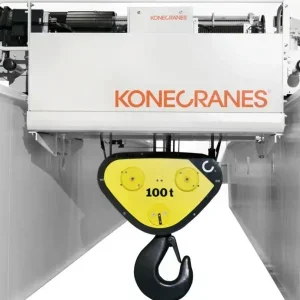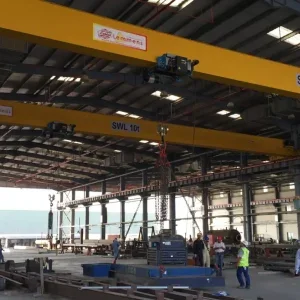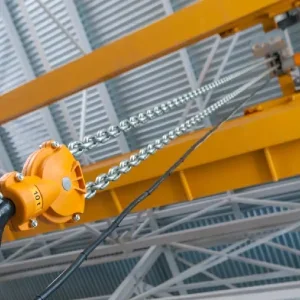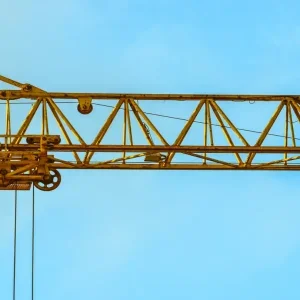We are running Stahl CraneSystems group internationally from here. Wherever R Stahl AG had mixed businesses, exporting both explosion-proof switch gear products and material handling equipment, we have established new companies. The Stahl CraneSystems group of companies has 12 companies in 12 countries.
We are splitting the responsibilities. Dr Peukert is responsible for research and development, the products, production, supply chain management, and I take the rest: finance, export and domestic sales.
We are forming a management team with colleagues as the group has been before.
Stahl remains untouched more or less in its functions and activities. KCI acquired the business and is running it as a separate group which is managed from this office in Kuenzelsau. We will not have the exchange of people, nor any plan to do so. The only thing is that I have been added.
Before the acquisition, the old mother company, R Stahl AG, took care of certain functions: finance, credit control, administration, IT. That’s my responsibility to replace those functions and implement them with the new Stahl CraneSystems group.
Naturally we will use sometimes services of the [new] group headquarters – including cash pooling, for example. We are not organised totally independently. We will use the corporate headquarters.
At the latest the end of the year all the ties to the old AG will be cut – more likely the middle of the year. We are replacing the IT system in parts – that project takes some time. In the meantime we have an agreement with AG to support us with some office administration. My goal is to separate them quickly.
I first came into the picture of the acquisition in late summer. That was when real discussions started. There was a cooperation for product development more than 10 years ago – but this was not a starting point for negotiations. It was just when people started to get to know each other.
HOIST: Why is Konecranes a better owner than R Stahl AG?
SB: There must be something that Finland does right. KCI did not really establish itself in the German market until 2000. The KCI brand is not so well known in Germany – but it is doing something about it. It has analysed the market well, and works with a different approach [than Stahl]. That does not mean that the KCI brand will vanish from the German market.
SB: KCI is strong, also financially. The group is much more focussed on material handling. 6% of its revenue is invested in new products. That was something never granted to the material handling division, even though it had good products. The future of the material handling division is very clear. The Stahl group did not want to invest.
KCI likewise analysed the situation from the other side. It wants to grow into the Central European and especially the German market. It wants to grow fast, and it could not pursue other acquisitions for various reasons.
The KCI and Stahl combined market shares for service, hoists and crane segments are not more than 20% of the German market.
If you take a pragmatic approach, this was the best way for both parties. One wanted to sell, another wanted to get into the market.
With regards to the IG Metall agreement, there is no specific deal. All existing agreements are valid and will be honoured. We are part of an employers’ association and will be doing the normal collective agreements.
There was an agreement to hold off any review of staffing until the end of 2006. KCI Konecranes was willing to discuss an extension of this, but R Stahl AG, KCI and the union discovered that there was no need to extend this. There is no noise about this.
The enterprise value is Euro 65m. The sale price was Euro 30.5m. There are two extra payments, which will be drawn from consolidated accounts submitted by R Stahl. They will be ready in 2-3 months.
HOIST: What do the factories do?
Otmar Buhmann (OB), marketing manager: The Kuenzelsau factory, the worldwide headquarters, makes wire rope hoists, chain hoists, winch components and crane components. It employs 360 people. The Ettlingen factory employs 80 people to make steel structures and assembles the bridge crane, winch and other specialty products.
There were 760 people employed by the company in total worldwide in 2004.
50% of components are sourced from outside. Kuenzelsau is mainly an assembly plant with a core competency in machining – drilling and gear cutting, drum cutting. Our motors come from outside, as well as other components.
SB: The plan is to maintain the existing product and production platforms. The Stahl product now will be the Stahl product in the future. Of course one reason why KCI Konecranes bought Stahl was because there are certain features and criteria related to products that make it different, not only in explosion proof. This is what we want to maintain. Obviously there are parts that KCI Konecranes cannot use and does not want to use. There are limits to a certain extent to the usability of common parts. What we will do, given that there are 50% of components outsourced, is that we have found we have a lot of suppliers who will sell products to KCI and to Stahl. As far as that is concerned, we will use the bigger purchasing power to get better prices for components. We will not put KCI-labelled components into Stahl products. That wouldn’t work. We have our own platform. Why would we destroy it?
If there is something, like a drum, a non-identity part which would make sense to include, I wouldn’t say totally no to buying it from KCI Konecranes in the long term. We are finding R&D talents in Stahl, and are very pleased with the level of expertise in the level of workmanship, awareness and timliness of the Stahl team. But for the short term, the clear answer is no.
There will be no interchange between KCI Konecranes and Stahl products.
Wherever service is available, Stahl will do it. KCI Konecranes will take care of maintenance of Stahl cranes if it has existing maintenance contracts. An existing maintenance contract may include many different cranes. A service company will buy components from KCI, Demag and others.
OB: The service market is split into many different companies.
SB: The Stahlplus distribution will not include KCI products, but it will continue.
The standard lifting division of KCI Konecranes is still the best fit for R Stahl. The special cranes element of Konecranes covers port cranes, harbour cranes, heavy applications for the steel industry.
The goal for Stahl CraneSystems group is to grow in a profitable manner. Its overall goal is to be on a profitable growth track.
The one problem of R Stahl AG, why the old owner was not as good – it was not able to finance the growth. KCI Konecranes will support it not only with money, but with the specific culture of the company – some of these elements which the corporate headquarters brings – even people. Although at the moment I am the only extra person they have employed.
Overall the funding is to finance the company in general and in growth, for the development of products and other development.
Stahl is looking at an interesting period of growth. Its order book is at a record level, its intake is at a record level. The short term main goal is to reorganise internally, to cope with the higher order intakes. That will keep us busy. Naturally you don’t want to see that order line bend down. We need to maintain that level and still grow further. We need new products and maintain the existing platform.
There is overlap between Stahl and KCI Konecranes products, but there is only limited overlap. It exists, but it doesn’t mean anything evil or bad. The market is very fragmented, and there are different sales channels. There is potential for a lot of growth even in overlapping markets.
OB: Stahl sells direct to end-users through Stahlplus and a vast net of sales branches with three to five salespeople per branch in Germany. But in a different market, such as the USA, it is all to strictly independent crane manufacturers. The service business there is up to crane manufacturers, too.
HOIST: How will new product development work?
SB: We will seek cooperation with Finland but keep the R&D department in workable condition and maybe grow it, I don’t know. There will be some joint work, there will be some development work only from here, and undoubtedly there will be some development tasks put down by KCI.
KCI already makes some explosion-proof equipment. It has no plans to extend its range.
OB: Stahl’s direct export sales for 2005 is about 55%, including indirect export, up to 65%.
SB: Stahl is a favourite supplier to turnkey general contractors building large projects like a cement plant in Indonesia. It is an interesting business, one that KCI Konecranes does not do at all. Demag does, though. It comes from this industrial background that Finland does not have. Keeping that business, the brand recognition, the platform, is of the utmost importance. It is not going to change at all. You have to have your own engineering forces to be able to help out the contractor with problems. If you have only standard products you can’t get these jobs – if you go only for standard business, you have a streamlined organisation.






